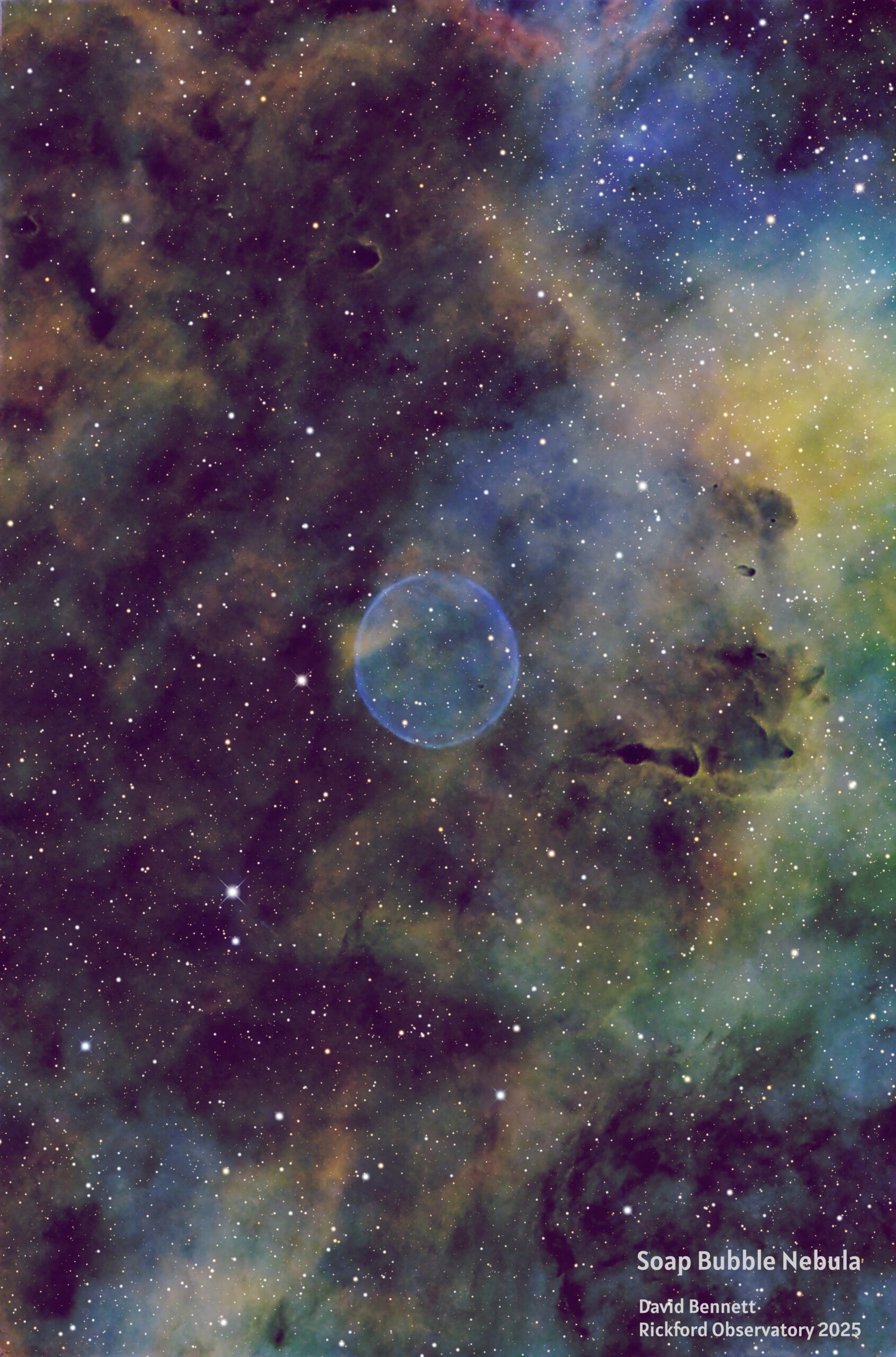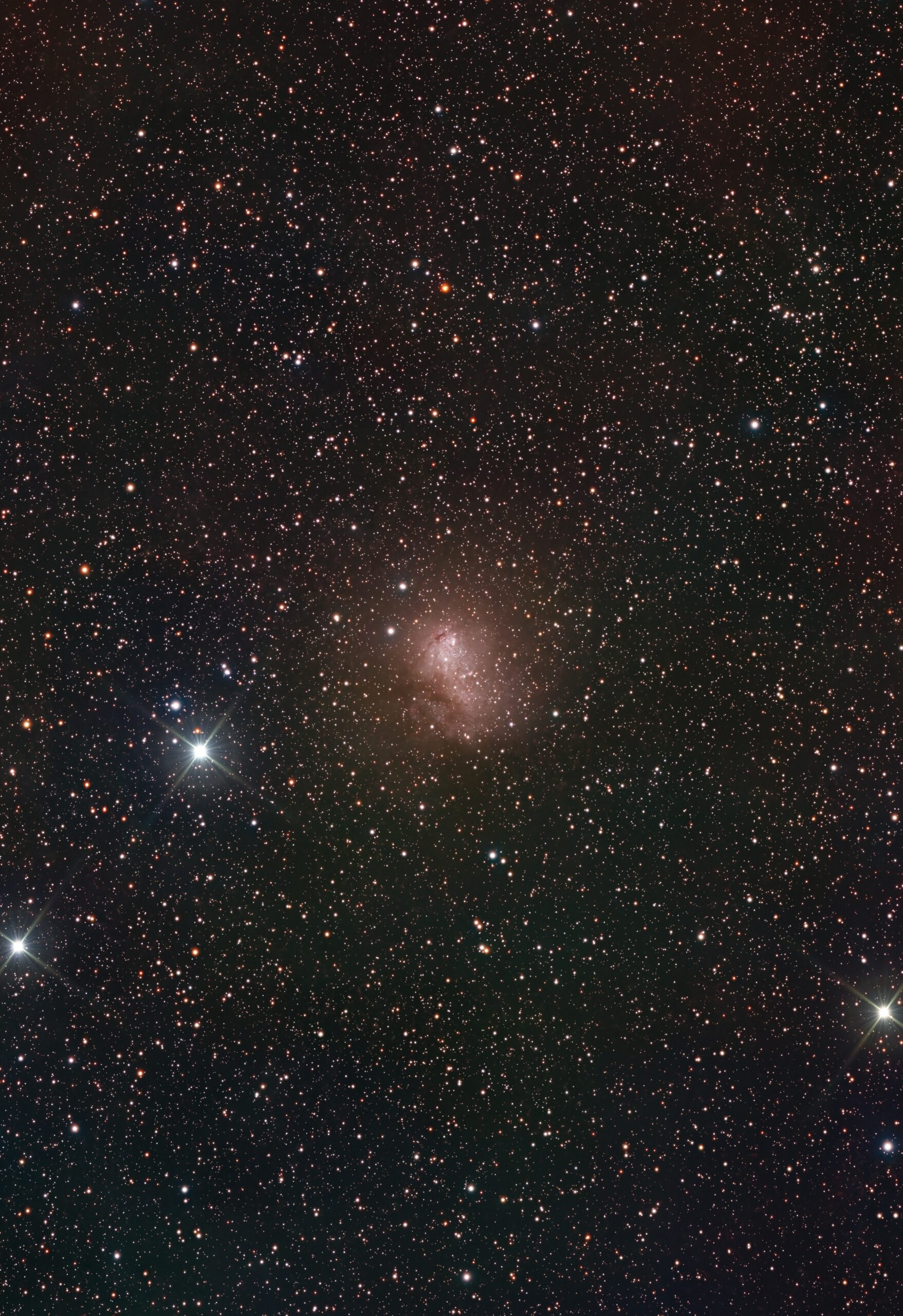2025 November 3
Deep Sky Update – October 2025
Another month seems to have flown by – just when you think that things might quieten down.
Observing weather in Orkney has not been the best for deep sky observing. We did have a couple of clearish nights where the northern lights made an appearance. And one early evening that was good enough to observe comet C/2025 A6 Lemmon visually and image with my Seestar S50. And during the aurora I was able to capture comet Lemmon in my widefield images too.
I had a nice weekend at the Comet & Meteor sections meeting in Edinburgh – though the weather (storm Amy) was waiting in the wings, my transport was not disrupted at all. Although it was a bit blowy for an extended period at home (usually the high winds blow through quite quickly) there was no damage apparent.
Al Nagler 1935 – 2025
I was sad to hear that the master astronomical optician Al Nagler passed away on October 27th. There will be few amateur astronomers that have not used a Tele Vue eyepiece, or that don’t have a few in their eyepiece collection. I think it’s probably true to say that Al revolutionised eyepiece design, whether it is from his eponymous types of Naglers, or the spectacular Ethos range which blazed the trail for 100 degree field of view eyepieces. Not long ago Tele Vue launched the Nagler Type 7 – and most recently announced the Delos 24mm. For those who like green writing on their eyepieces these may be on the Christmas list.
Deep Sky Section Meeting 2026 – March 28th 2026
The venue for the meeting is Dean Close Preparatory School Cheltenham and the programme is progressing well. Just a couple of things to finalise and then I’ll be able to announce the line-up. I am please the Prof. Albert Zijlstra will be the keynote professional speaker on the day, and will talk about current trends in planetary nebulae research. I have been trying to get Albert to speak to the section for a few years now, so I hope this time we will be lucky with no last minute hiccups.
If anyone would like to give a short talk at the meeting please let me know, as although the programme is nearly full I could have a space available.
Tickets will go on sale soon.
Double Stars for November – Peter Morris
This month I move along to Zodiac to Pisces. One has to start with Alpha Piscium or Alrescha (STF 205). This is at the bottom of the constellation and is a tight double with a current separation of 1.9, It is a binary with a 3,267-year period which has just passed its minimum separation, but there is something odd going on here and it is not behaving as it should, so clearly a binary to watch. For more details see my piece in the next issue of Popular Astronomy. The magnitudes are 4.1 and 5.2; the position angle is 263.5°. Befitting the fact that both stars are A type stars, they are both seen as brilliant white.
A bit higher up and to the west is Zeta Piscium or Revati (STF 100), named after a Hindu Zodiacal mansion. It is a binary, but the orbital period must be very long as its separation has only changed by 2.4 degrees since 1755. The main star is magnitude 5.2 and the secondary is 6.3; the position angle is 62.9°. They are stellar types A and F, but oddly they are generally both seen as yellow-white (goldish-white to use Sissy Haas’s description). The secondary is a spectroscopic binary with a period of nine days and the main star is a very tight binary with a separation of 0.15 arcseconds.
Moving to the top of the constellation, close to Andromeda, we find Psi1 Piscium (STF 88) which is a wide double with a separation of 29.8 arcseconds. The main star is magnitude 5.3 and the secondary is very similar, being 5.5; the position angle is 159.20°. It is a binary, but again the period must be very long as there has been little change in the separation since 1755 (0.6 arcseconds). The two stars are A type and B type, but they are seen as yellow-white rather than white. The main star is (again) a very tight binary with a separation of 0.04 arcseconds. There is a third member of the group which is magnitude 10.71 and is 90.4 arcseconds from the main star; the psitioin angle is 123.7°, which means it is almost in line with AB. It is uncertain if it is a binary or not.
Seven degrees north of Psi1 Piscium is 65 Piscium (STF 61), which is only a couple of degrees from the boundary with Andromeda. The magnitudes of the two stars are virtually identical (6.33 and 6.34) and the separation is 4.2 degrees; the position angle is 116°. This is also a binary where its separation and position angle have hardly changed since 1783. They are both F type stars and are seen as yellow.
I cannot leave Pisces without mentioning STT 18, which lies to the west of Zeta Piscium. It is a dim double, the magnitudes are 7.9 and 9.7, and the separation is a manageable 2.1 arcseconds; the position angle is 213°. I have not observed it myself (yet), but its colours have been described as white and lilac; the spectral types are F and G. Its interest lies in the fact that it is a binary with a relatively short period of 386.5 years. We are currently in the fortunate position that the separation is currently close to its widest and it will continue to widen for another hundred years or so. The separation currently widens at about 0.01 arcseconds a year. As the photographic positions have been jerking round somewhat, it would bear close observation.
October Object of Interest
October’s target was the local group, irregular galaxy IC 10 in Cassiopeia. Many thanks to those that had a go at this object; Fred Stevenson, Jonathon Elliott, David Strange, Iain Cartwright, Alan Thomas and Ivan Walton. Iain & Jonathon had a few goes at it over the month, and here is one of Jonathon’s.
You can see all the images on the Object of Interest Gallery
Object of Interest for November
Our target for November is an intermediate spiral galaxy in Cetus NGC 1087. Many thanks to Jim for the suggestion. It culminates at around midnight in November so should be well placed for observing. There are a number of galaxies nearby which might be captured in a wide-field view. We will look forward to seeing what you see.
Deep Sky Picture of the Month
There were 80 deep sky objects in the members image gallery for October, which is about half the number of September, so October must have been a month of poor weather. Many impressive images as always and my pick for this month is of The soap Bubble Nebula by David Bennett which is a massive 57hours of combined 300s exposures.

And Finally
As always, I hope you have good, clear, dark skies in the month ahead.
Callum
| The British Astronomical Association supports amateur astronomers around the UK and the rest of the world. Find out more about the BAA or join us. |

